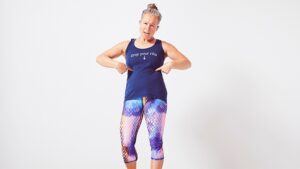
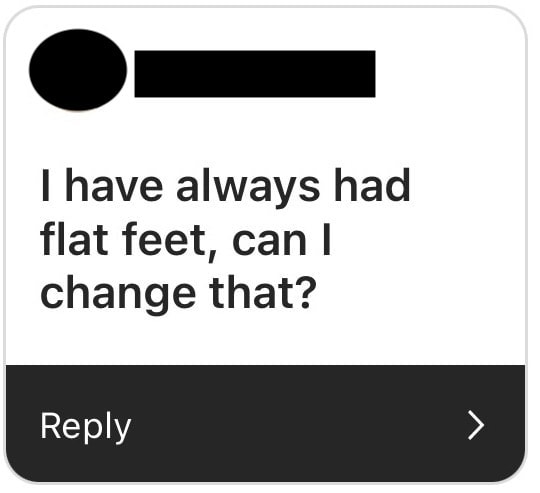
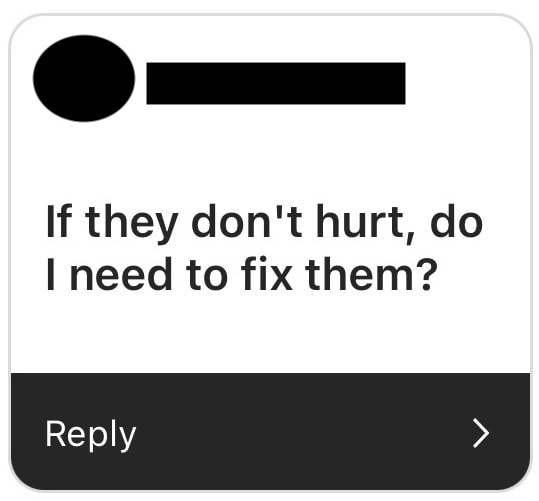
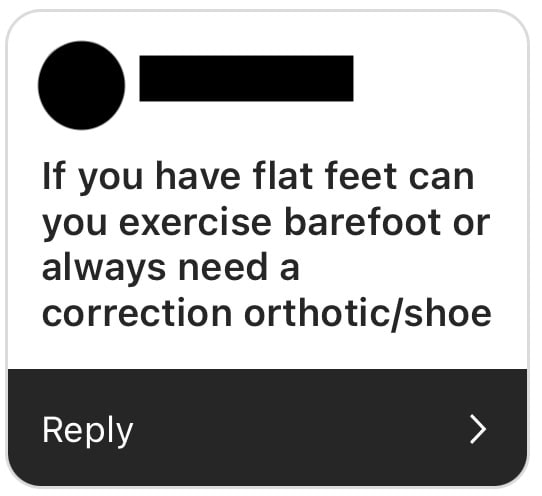
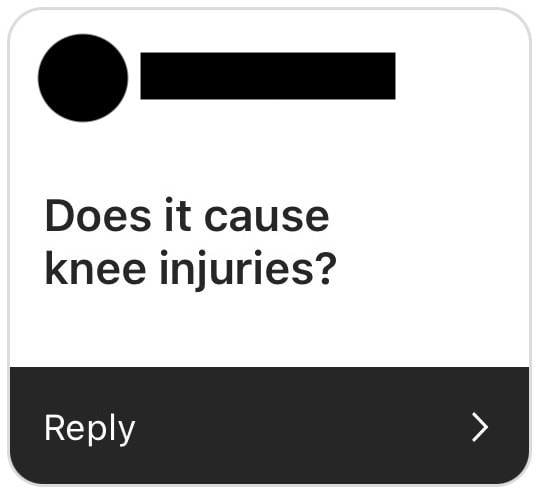
There’s a ton of confusion out there about flat feet! Lots of people are told they have flat feet and that they’re the reason for foot pain and body issues.
While that may be true for some, it’s also true that flatter feet can absolutely be functional.
What’s more, ‘flat feet’ result from a combination of our genetics, our injuries and our movement histories. That means that even very flat feet can often become pain free and functional with smart exercise and movement choices!
I was curious, so I polled my Instagram folks & asked you for your most burning questions about flat feet. This post answers your top 5 questions – including what flat feet actually are, how to know if you have them and how you can fix them (if you even need to).
Question #1: What Are Flat Feet Really?
Flat feet, also referred to as ‘fallen arches’, ‘overpronation’ or ‘pes planus’ are common! When standing, people with flat feet will have most of, if not the entire sole touching the ground. This could be because pressure has flattened all the bones of the feet, or simply because you have super low arches.
Fun fact – there’s actually no formal medical definition of ‘overpronation’ so the term is often unhelpful. It’s actually essential to be able to pronate – or flatten – your feet!
I like to think about foot intrinsic movement as a spectrum between pronation (untwisting to absorb shock) and supination (twisting into a rigid, arched shape to create a rigid lever).
A ‘flat foot’ is one that’s ‘stuck’ in the shock absorption phase of movement – so it’s going to be wider, longer, and untwisted relative to a supinated foot. You’ll typically also see the ankles rolling inwards, knees pointing inwards when bent, and hips in an internally-rotated position.
Ideally we want our feet to move from flattened into arched, and back from arched into flattened when we walk.
Feet need to travel between these shapes on every step for healthy walking but many of us with flat feet are ‘stuck’ in the lengthened, widened, ‘untwisted’ phase of their movement cycle.
Which means that when walking, people with ‘flat’ feet typically have to use compensatory patterns to move forward (for example, your foot might twist to push off instead of pushing straight forward, which is why bunions and calluses on the inside edge of the big toe can go along with flat feet). This is one reason you can see knee, hip, pelvic floor & low back issues running alongside flatter feet.
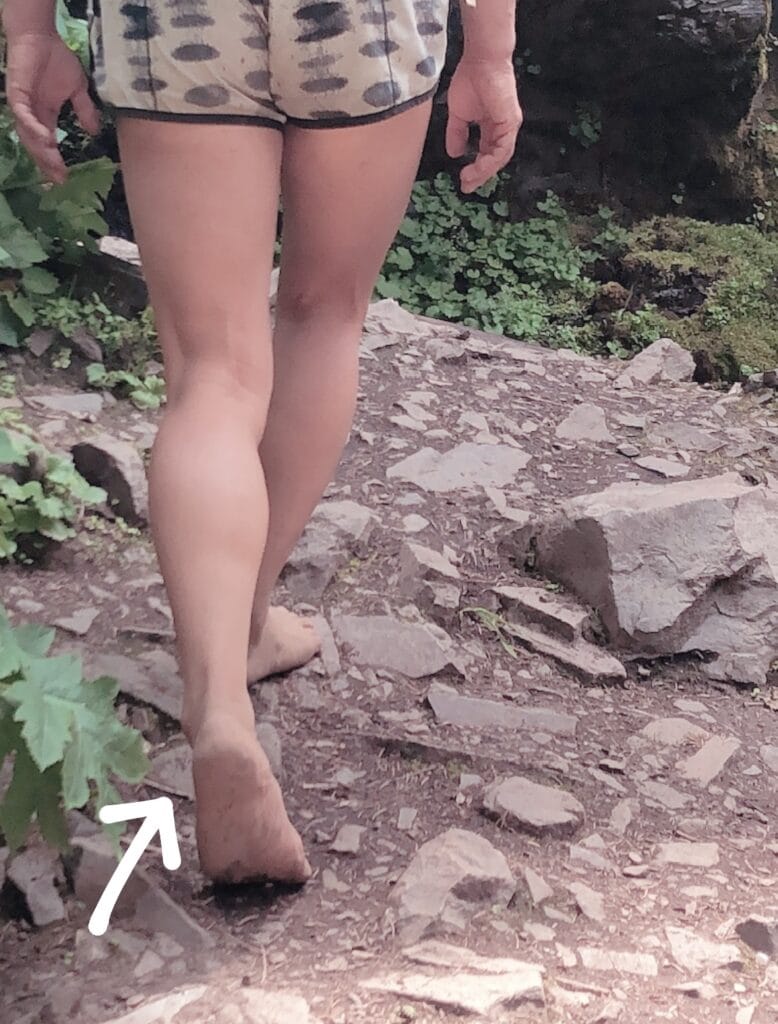
Are flat feet genetic?
Our foot shapes are typically the result of the interaction between our DNA and our movement. Some people are definitely more prone to being flat-footed (or high arched) but the way we move is what determines how functional our feet are. This is great news because it means that most flat feet aren’t genetic per se, and most people can do a ton to ‘unflatten’ their feet.
However there are sometimes genetic conditions that create bony tissue restrictions in our feet that cause flat-footedness and can’t be resolved through movement (such as forefoot varus, or a tarsal coalition). Foot injuries can also be the cause of bony changes. If you suspect your flat feet are a result of an injury or or a genetic condition, I recommend consulting with a naturally-focused clinician to get an assessment.
Hypermobility disorders like EDS can also lead to flat feet, in which case strengthening your foot muscles should be a top priority and passive mobilization and stretching won’t be the best idea. Some folks with hypermobility will still benefit from mobility work, however – it depends on your unique body. Explore with caution and consider getting help from a hypermobility expert.
Question #2: How Do You Know If Your Feet Are ‘Flat’ or ‘Stuck’ In Pronation?
If you’re not sure whether you have flat feet or not, here are some clues to look for:
👣 Little or no visible arch when standing
👣 Ankles roll inwards
👣 Hips are internally rotated when feet are placed straight forward
👣 Feet may be very flexible or very stiff & rigid
👣 Possibly goes along with:
👉 foot turn out
👉 plantar fasciitis
👉 bunions
👉 pelvic floor issues
The image below should give you a good idea of what flat feet look like. You can see the ankles roll inward, there’s no visible arch and the feet are turned out.
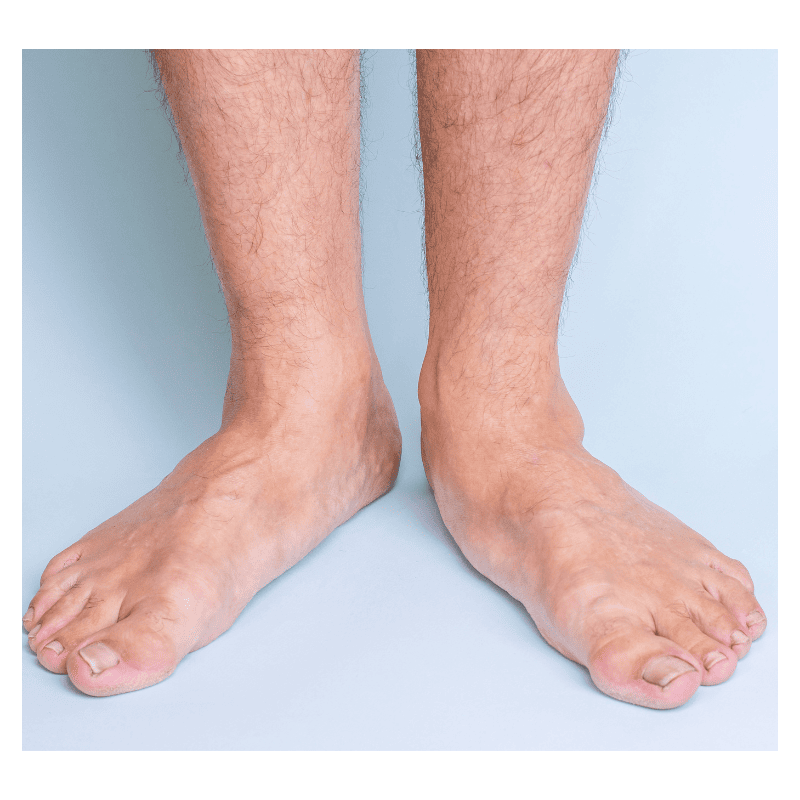
Question #3: Do You Need To ‘Fix’ Flat Feet If They Don’t Actually Hurt?
This is a hard question to answer and my typical response is, ‘It depends.’ Functional flat feet definitely exist – so if your feet supinate well when you walk and you just have lower arches you’re likely completely fine.
However, the dynamics of flat feet CAN and DO travel up the body – as mentioned above, you’ll often see ankle, knee, hip & pelvic floor stuff associated with flat-footed patterns.
So if you don’t supinate when you walk, or have foot pain or issues in any of those upstream areas, as well flat feet, it’s probably a good idea to work on your feet.
Not sure if you supinate when you walk? This can be tricky to figure out on your own but clues are having a bunion as well as flat feet, or having a big callus on the lower inside edge of your big toe.
‘Unflattening’ feet really comes down to building your supination capacity. Stiff feet and sticky hips restrict your supination ability – and most of us have both! So that really means you need to start by working on foot & hip mobility.
Having mobile feet & hips is never a bad idea – so as I see it, there’s really no downside to working on building your foot function even if you’re not currently in pain. And you may even find that you improve in ways you didn’t expect!
Coming back to the original question – “Do you ‘need’ to work on flat feet that don’t hurt?” Ultimately it’s your call and only you know what’s best for you. However, chances are that you’ll find some long term upside – and you’ll never know unless you try.
Post-tibial tendonitis is another issue associated with flat feet. This is best managed by working under the guidance of a physical therapist. You can find a list of great clinicians on the Healthy Foot Alliance website.
Question #4: How Can You ‘Unstick’ Your Feet & Get Functional Arches?
I got a lot of responses when I asked my online community what they wanted to know about flat feet, but the one question that came up over and over again was – “Can flat feet be reversed?” And the answer is ABSOLUTELY YES! Or if not reversed, you can at least do a TON to improve your foot strength & function and supination capacity.
Here’s what you should prioritize working on:
1️⃣ Intrinsic Foot Muscle Strength
Flat feet are usually weak feet. We have lots of tiny muscles in our feet that don’t get used a lot when we wear shoes all the time. So, improving your intrinsic foot muscle strength is one key to rebuilding your arches!
It’s especially important to make sure your big toe is strong & mobile. The muscles that pull the big toe towards the centre-line of your body (a movement called big toe abduction) are essential to rebuilding your arches.
Your big toe also has to be able to bend backwards – called big toe extension. In walking, big toe extension is paired with supination, so it’s important to have this capacity if you want to unflatten your feet!
The video below is a great exercise for improving big toe mobility.
Want to take it a step further? My (free) Free Your Feet program includes key exercises for improving big toe abduction, big toe extension and other important areas of foot strength. Sign up right now and start building the foot strength you need for healthier, happier and more mobile feet!
2️⃣ Mid-foot Mobility
In order to unflatten your feet, you need to be able to ‘twist’ or supinate your feet. This means you need mobility through the mid-foot area, where lots of small bones are designed to lock (& unlock) when we’re walking well. So good mid-foot mobility is essential when it comes to unflattening your feet!
And yes, it’s surprising but this means that most flat feet actually need more mid-foot mobility – many flat feet are stiff and work a bit more like a paddle than a foot!
Here’s the best exercise I know for mobilizing your feet (and bonus – it’s great no matter what type of foot you have – flat, high arched or somewhere in the middle – so share it with your friends & family who want healthier feet)!
And as a bonus – it’s also a great way to ease into transitioning to minimal shoes and help you become more comfortable when walking on textured surfaces barefoot!
3️⃣ Hip Rotation Mobility & Strength
Hip rotation is the prerequisite for all other movements of the hips, including healthy walking. You wouldn’t think it but your hips actually have to rotate externally as you push off when you walk. This hip rotation travels all the way down your legs to your feet, and is a bit part of what creates the supination movement that ‘unflattens’ our feet. Good hip mobility & control will help you lift your arches from the top down!
But chances are, your hips spend most of the day stuck around 90 degrees in a chair. That means they’re probably limited in their range of motion, including rotation.
In order to improve walking mechanics (supination & pronation) we need fully mobile hips! (Another bonus – mobile hips are happier hips!)
The exercises I teach in my Joints for Life – Controlled Articular Rotations (CARs) are a great starting point to help improve your hip range of motion and teach you how to safely control and strengthen those ranges of motion. Learn more about Joints for Life and why CARs are such a powerful tool here.
4️⃣ Supination Movement Patterning
We’ve talked a lot about supination & pronation and how important they both are when it comes to walking.
Here’s a bit more of an explanation of what’s going on in pronation & supination – and one of my favourite exercises to help restore your supination patterns.
My Free Your Feet program includes several of great exercises to help you build your pronation & supination capacity as well (grab it here).
5️⃣ Standing alignment
Many people with flat feet are unconsciously practicing flat feet all day long when they stand. By allowing your feet to roll onto their inside edges and your ankles to collapse inwards as you’re standing, you’re getting better at having flat feet!
By redistributing your weight, picking up your arches, and slightly externally rotating your hips, you can stand with a more ‘neutral’ foot. You may find this requires standing with a bit more muscle activation and awareness than you’re used to using, but that’s exactly why it will help ‘unflatten’ you!
Bonus – this change will be super helpful for your pelvic floor! The hip muscles you use to maintain stable arches are actually a part of your pelvic floor and they get sad when your feet are always being squashed flat!
Question #5: Can I Wear Barefoot Shoes Or Will I Always Need To Wear An Orthotic?
This is the second most asked question I get about flat feet. I’m a huuuuuge fan of minimal shoes but if you have flat feet you’ve probably been told that you need orthotics and arch support. Hearing this can make it hard to tell whether or not wearing barefoot shoes are a smart option.
I think barefoot shoes are probably a great idea for you as long as you’re up for going slowly and doing exercises to support your transition. Here’s why:
1️⃣ Wide toe boxes allow all of our toes to spread and our big toes to abduct & extend. This extra space is essential to having functional arches because of how our foot muscles are set up and also helps create supination (your missing pattern). Bonus: wide toe boxes let you use toe spacers like CorrectToes which can be a helpful option to naturally strengthen your arches.
2️⃣ Flexible soles allow for more mobility (since our feet can feel the ground) and let your feet travel through both supination and pronation instead of keeping them basically immobilized.
3️⃣ Minimal footwear has been shown to help strengthen feet – and stronger feet can supinate better.
4️⃣ Almost all conventional shoes have raised heels (yes – even your gym sneakers!). Lifted heels overload our forefeet and contribute to foot flattening. Minimal shoes have no heel lift and are zero-drop – allowing your foot to move naturally and freely.
5️⃣ The conventional approach to flat feet is to support them – which doesn’t deal with the root causes, whether those are foot weakness, foot stiffness, or a lack of hip mobility. In fact, it just exacerbates the causes. Working on your feet by building strength & mobility & improving your movement patterns – will serve your body better in the long run!
Having said that, supportive orthotics can help flat feet if you’re in pain, so you may want to start by using orthotics and a transitional shoe (such as Altras or Topos), doing plenty of foot exercises, and then slowly transitioning to a more minimal shoe (click here to learn more about how to safely transition to minimal shoes).
I wouldn’t recommend just switching to barefoot shoes and hoping they’ll ‘fix’ your feet by themselves. But if you’re willing to explore carefully & do the work with foot & hip exercises, then yes, barefoot shoes can be a fantastic option. (True story – I was once told that my ‘flat’ feet would always need orthotics. And here I am, 10 years later barefoot or in minimal shoes 100% of the time!!!)
Bonus Question: Does Having Flat Feet Impact Your Knees & Can It Cause Knee Injuries?
A lot of people also asked whether flat feet can cause knee issues. The answer is absolutely yes. Our walking patterns are important for every joint in our body – definitely including the knees!! The pronation & supination patterns I’ve been talking about require specific movements from our knees & hips as well as our feet. And if we don’t get the movements we need, we use compensations that often lead to pain & injuries.
In fact, I have a personal story for this one – my left knee started hurting a couple of years ago when I went into a deep knee bend. Fast forward two years and I realized that my left foot was really struggling to supinate. I’ve been working hard on my left foot supination for about six months now and guess what? That knee has cleared up as well!
In my opinion, making sure you have effective, functional pronation and supination patterns is one of the best ways you can care for your knees – and the rest of you too!
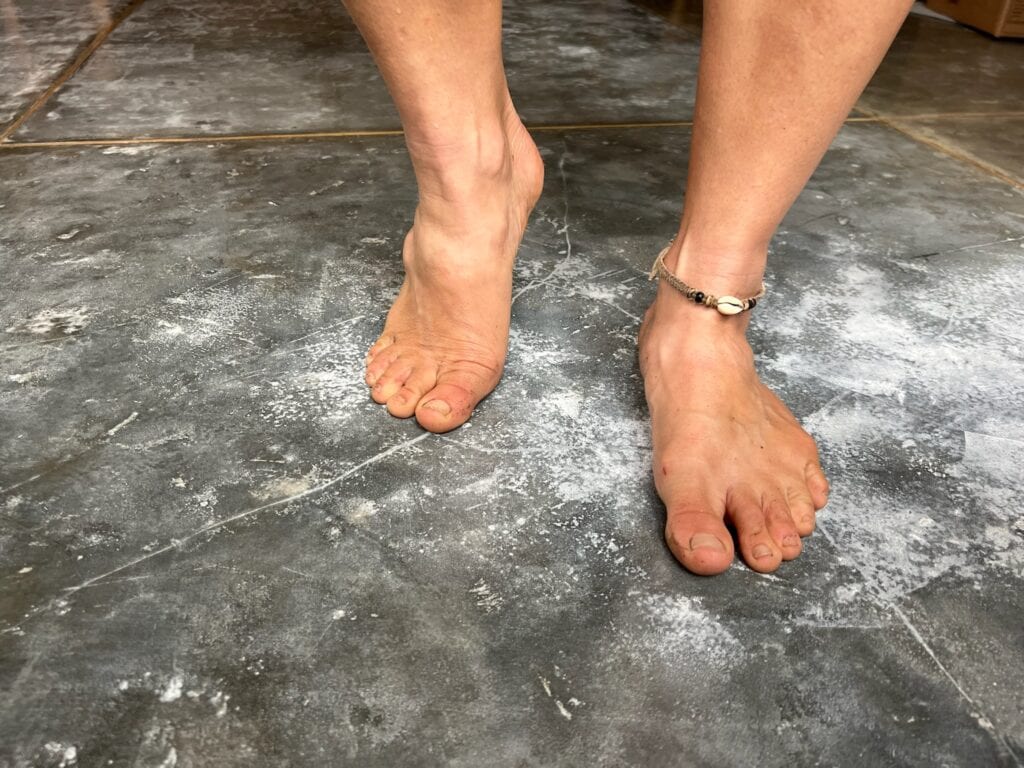
When it comes to flat feet we really want to focus on building more capacity & function. Strength, mobility and supination capacity will work together to support your foot health – but also your ankles, knees, hips & pelvic floor!
Yes, restoring foot function can be a life-long process but it’s definitely worth it. Having a dedicated footwork practice is likely to lead to major improvements in other areas of the body – I’m a prime example of what can happen when you optimize your foot health!
If you’re ready to take the first step toward improving your feet, the exercises in my Free Your Feet freebie and the videos in this post should get you a long way!




